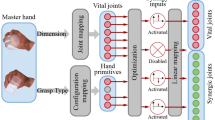Abstract
In this work, a study on postural synergies has been conducted on an under-actuated anthropomorphic hand , the SCHUNK Five-Fingered Hand (S5FH). Human hand grasps are mapped on the robotic hand using fingertips measurements, obtained with an RGBD camera sensor, and inverse kinematics. Since the S5FH is under-actuated, an approximate solution can be obtained using the differential kinematics mapping between the motor space and the Cartesian space and a closed-loop inverse kinematics (CLIK), based on a high-rectangular hand Jacobian that takes into account the mechanical synergies of the hand. The so-computed motor synergies have been tested for hand control during grasping. The motor current measurements have been used to limit the grasping forces trough a motor position control in the synergies subspace.
Access this chapter
Tax calculation will be finalised at checkout
Purchases are for personal use only
Similar content being viewed by others
References
Wimboeck, T., Jan, B., Hirzinger, G.: Synergy-level impedance control for a multifingered hand. In: Proceedings IEEE/RSJ International Conference on Intelligent Robots and Systems, pp. 973–979. San Francisco (2011)
Ficuciello, F., Palli, G., Melchiorri, C., Siciliano, B.: Experimental evaluation of postural synergies during reach to grasp with the UB Hand IV. In: Proceedings IEEE/RSJ International Conference on Intelligent Robots and Systems, pp. 1775–1780, San Francisco (2011)
Geng, T., Lee, M., Hulse, M.: Transferring human grasping synergies to a robot. Mechatronics 21(1), 272–284 (2011)
Sun, S., Rosales, C., Suarez, R.: Study of coordinated motions of the human hand for robotic applications. In: Proceedings of the Anchorage, Alaska, IEEE International Conference on Robotics and Automation, pp. 776–781 (2010)
Gioioso, G., Salvietti, G., Malvezzi, M., Prattichizzo, P.: Mapping synergies from human to robotic hands with dissimilar kinematics: An object based approach. In: IEEE International Conference on Robotics and Automation, Workshop on Manipulation Under Uncertainty, Shangai (2011)
Ficuciello, F., Palli, G., Melchiorri, C., Siciliano, B.: Postural synergies of the ub hand iv for human-like grasping. Robot. Autonom. Syst. 62, 357–362 (2014)
Palli, G., Melchiorri, C., Vassura, G., Scarcia, U., Moriello, L., Berselli, G., Cavallo, A., Maria, G.D., Natale, C., Pirozzi, S., May, C., Ficuciello, F., Siciliano, B.: The DEXMART hand: mechatronic design and experimental evaluation of synergy-based control for human-like grasping. Int. J. Robot. Res. 33, 799–824 (2014)
Ficuciello, F., Palli, G., Melchiorri, C., Siciliano, B.: A model-based strategy for mapping human grasps to robotic hands using synergies. In: Proceedings of the IEEE/ASME International Conference on Advanced Intelligent Mechatronics, Wollongong, Australia, 2013, pp. 1737–1742 (2013)
Ficuciello, F., Palli, G., Melchiorri, C., Siciliano, B.: Planning and control during reach to grasp using the three predominant UB Hand IV postural synergies. In: Proceeding IEEE International Conference on Robotics and Automation, Saint Paul, 2012, pp. 2255–2260 (2012)
Feix, T., Pawlik, R., Schmiedmayer, H., Romero, J., Kragic, D.: The generation of a comprehensive grasp taxonomy. In: Robotics, Science and Systems, Workshop on Understanding the Human Hand for Advancing Robotic Manipulation, Washington (2009)
Cutkosky, M.: On grasp choice, grasp models, and the design of hands for manufacturing tasks. IEEE Trans. Robot. Autom. 5(3), 269–279 (1989)
Ruehl, S., Parliz, C., Heppner, G., Hermann, A., Roennau, A., Dillman, R.: Experimental evaluation of the schunk 5-finger gripping hand for grasping tasks. In: Proceedings of the Bali, Indonesia, IEEE International Conference on Robotics and Biomimetics pp. 2465–2470 (2014)
Schunk Hand Webpage. http://mobile.schunk-microsite.com/en/produkte/produkte/servoelektrische-5-finger-greifhand-svh.html
schunk_svh_driver. http://wiki.ros.org/schunk_svh_driver
Acknowledgements
This research has been partially funded by the EC Seventh Framework Programme (FP7) within RoDyMan project 320992. The authors are solely responsible for its content. It does not represent the opinion of the European Community and the Community is not responsible for any use that might be made of the information contained therein.
Author information
Authors and Affiliations
Corresponding author
Editor information
Editors and Affiliations
Rights and permissions
Copyright information
© 2018 Springer International Publishing AG
About this chapter
Cite this chapter
Ficuciello, F., Federico, A., Lippiello, V., Siciliano, B. (2018). Synergies Evaluation of the SCHUNK S5FH for Grasping Control. In: Lenarčič, J., Merlet, JP. (eds) Advances in Robot Kinematics 2016. Springer Proceedings in Advanced Robotics, vol 4. Springer, Cham. https://doi.org/10.1007/978-3-319-56802-7_24
Download citation
DOI: https://doi.org/10.1007/978-3-319-56802-7_24
Published:
Publisher Name: Springer, Cham
Print ISBN: 978-3-319-56801-0
Online ISBN: 978-3-319-56802-7
eBook Packages: EngineeringEngineering (R0)




